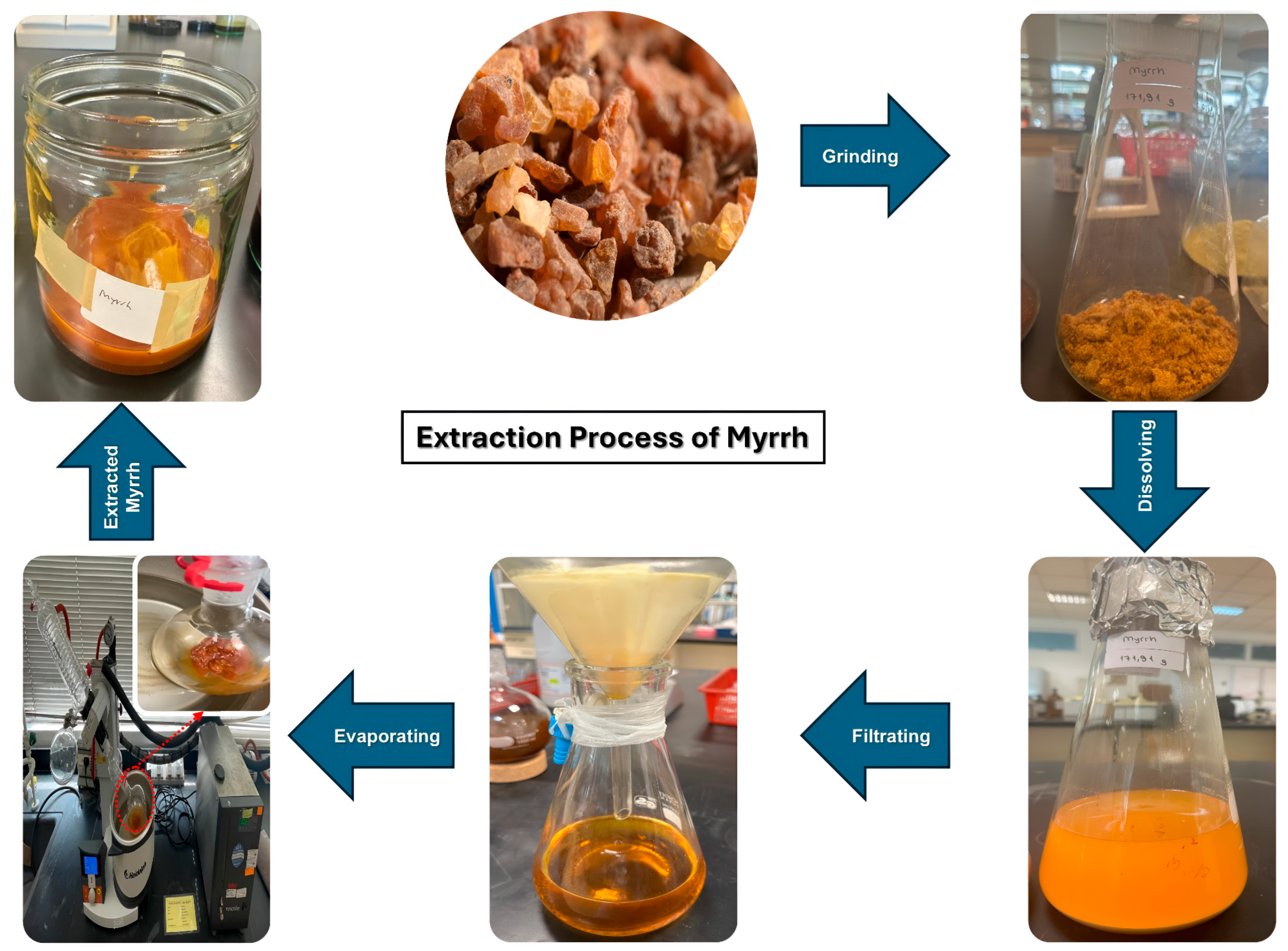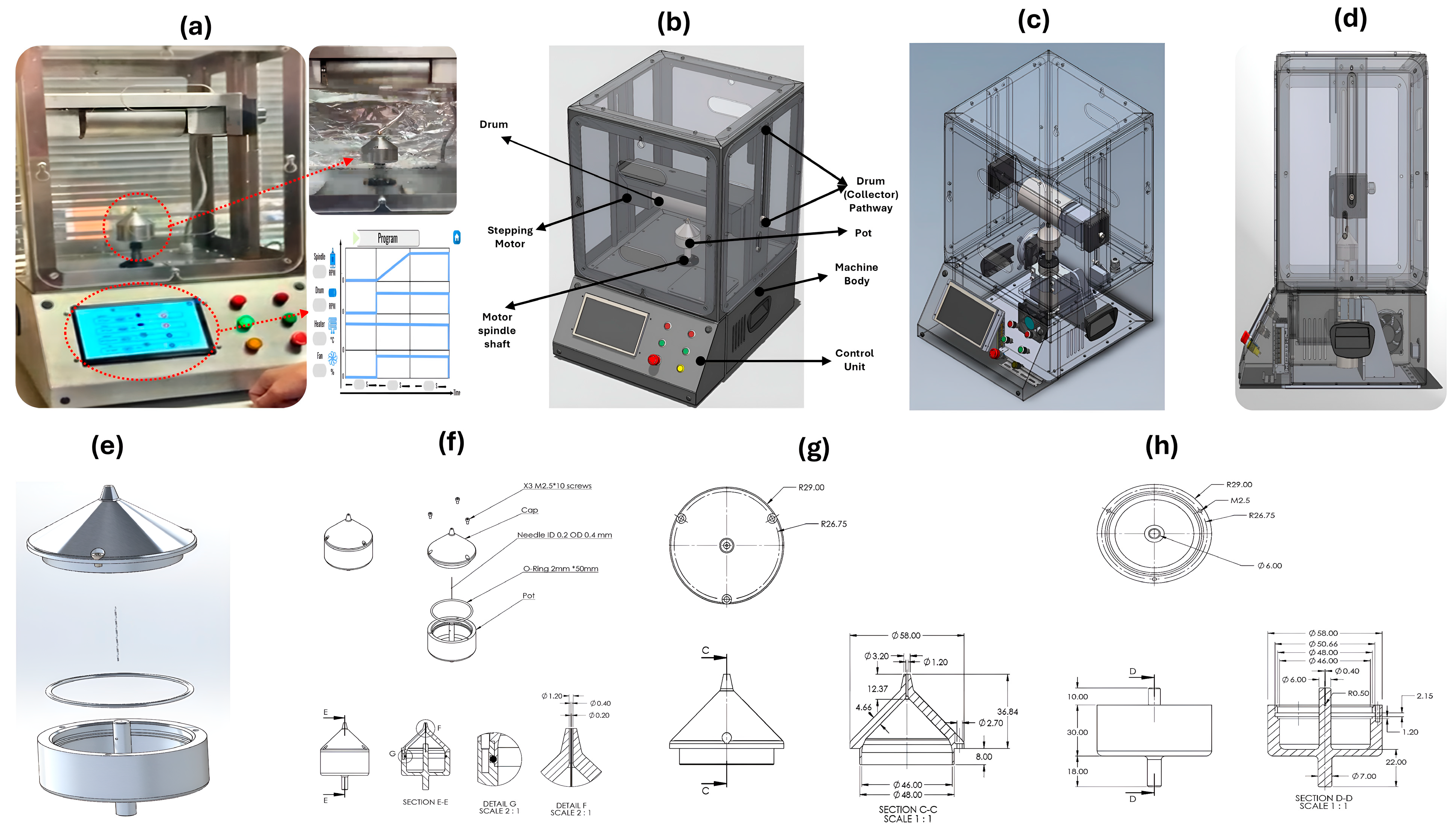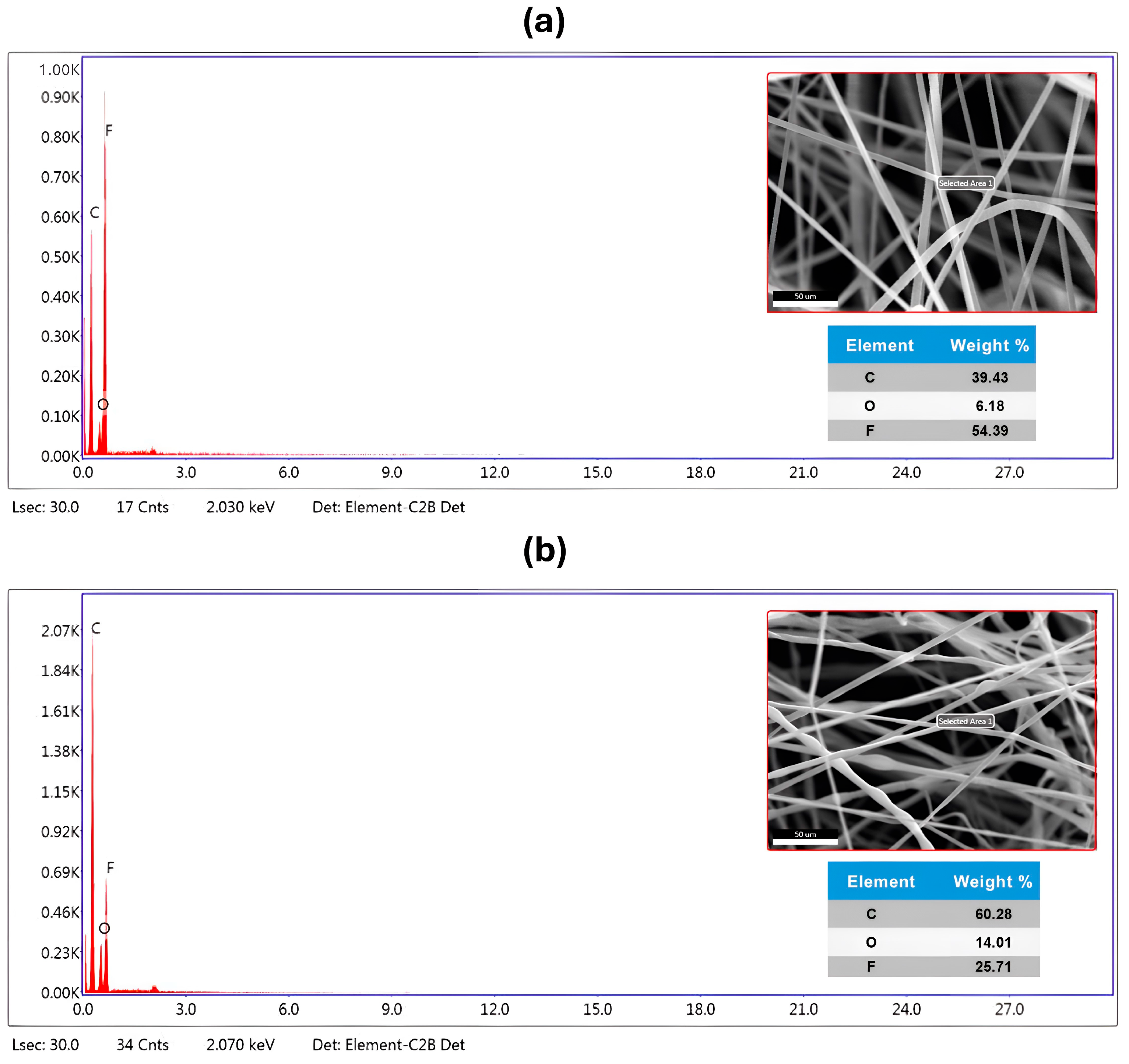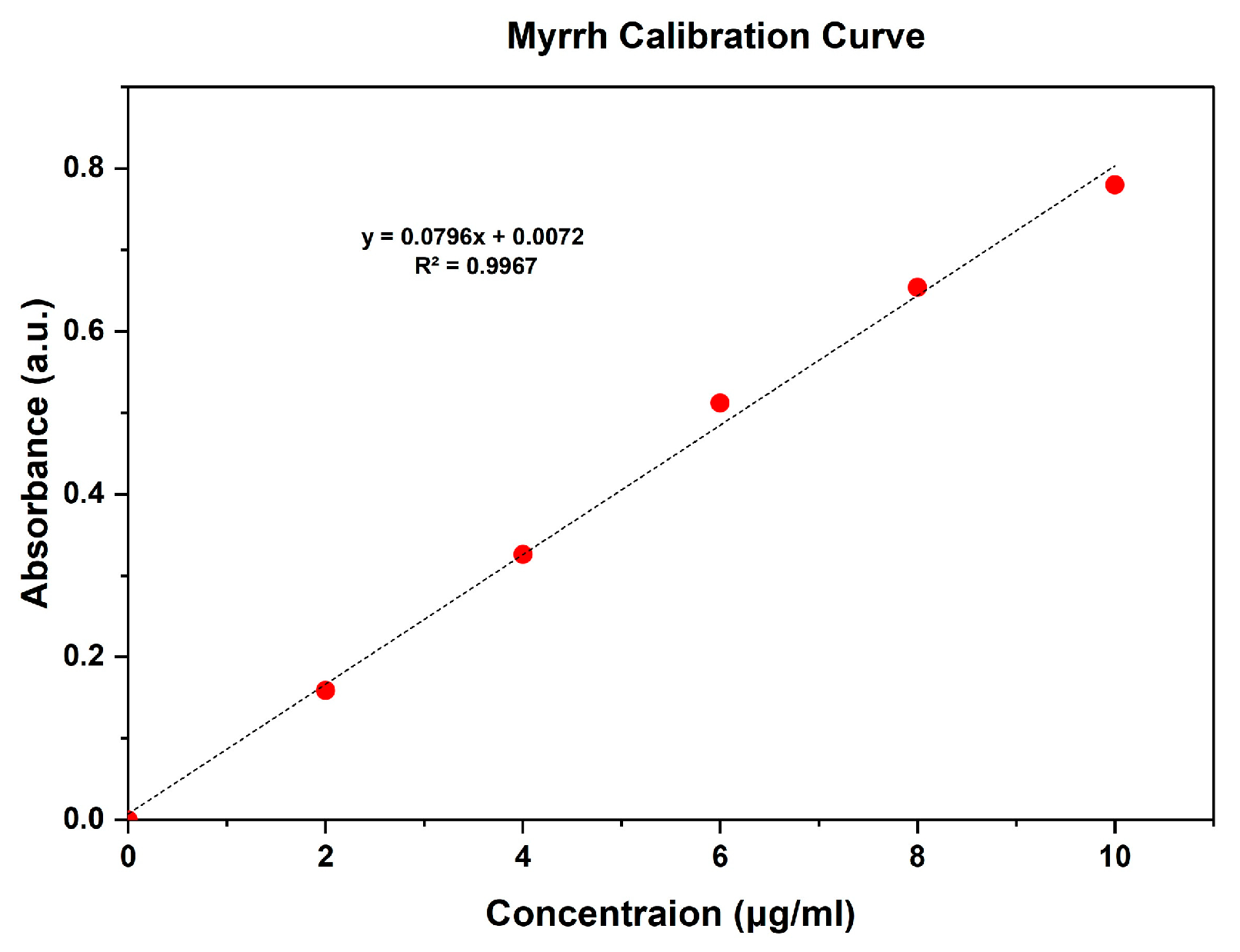Fabrication of Bio-Composite of Piezoelectric/Myrrh Nanofiber Scaffolds for Wound Healing via Portable Gyrospun
Abstract
1. Introduction
2. Materials and Methods
2.1. Materials
2.2. Fabrication of Myrrh/PVDF-TrFE Nanofibers
2.2.1. Extraction of Myrrh
2.2.2. Preparation of the Myrrh, PVDF-TrFE, and Myrrh/ PVDF-TrFE Solutions
2.2.3. Fabrication of the Scaffolds by Gyrospining
2.3. Characterization of Composite Fibers
2.3.1. Scanning Electron Microscopy (SEM)
2.3.2. Energy-Dispersive X-Ray Spectroscopy (EDX)
2.3.3. Fourier Transform Infrared Spectroscopy (FTIR)
2.3.4. X-Ray Powder Diffraction (XRD)
2.3.5. Thermogravimetric Analysis (TGA)
2.3.6. Encapsulation Efficiency
2.3.7. In Vitro Drug Release
2.3.8. Antimicrobial Activity
Disk Diffusion Approach for Antimicrobial Evaluation
3. Results and Discussion
3.1. Morphological Characterization of Fibers
3.2. Elemental Characterization of Fibers
3.3. Fourier Transform Infrared Spectroscopy (FTIR)
3.4. XRD Analysis of Gyrospun Nanofibers
3.5. Thermogravimetric Analysis (TGA)
3.6. In Vitro Drug Release
3.7. Antimicrobial Activity
4. Conclusions
Author Contributions
Funding
Institutional Review Board Statement
Informed Consent Statement
Data Availability Statement
Conflicts of Interest
References
- Pereira, R.F.; Bartolo, P.J. Traditional therapies for skin wound healing. Adv. Wound Care 2016, 5, 208–229. [Google Scholar] [CrossRef] [PubMed]
- Sandoval, C.; Rios, G.; Sepulveda, N.; Salvo, J.; Souza-Mello, V.; Farias, J. Effectiveness of copper nanoparticles in wound healing process using in vivo and in vitro studies: A systematic review. Pharmaceutics 2022, 14, 1838. [Google Scholar] [CrossRef] [PubMed]
- Brem, H.; Tomic-Canic, M. Cellular and molecular basis of wound healing in diabetes. J. Clin. Investig. 2007, 117, 1219–1222. [Google Scholar] [CrossRef]
- Thomson, P. Immunology, microbiology, and the recalcitrant wound. Ostomy/Wound Manag. 2000, 46, 77S–82S, quiz 83S. [Google Scholar]
- McGuire, L.; Heffner, K.; Glaser, R.; Needleman, B.; Malarkey, W.; Dickinson, S.; Lemeshow, S.; Cook, C.; Muscarella, P.; Scott Melvin, W. Pain and wound healing in surgical patients. Ann. Behav. Med. 2006, 31, 165–172. [Google Scholar] [CrossRef]
- Sayampanathan, A. Systematic review of complications and outcomes of diabetic patients with burn trauma. Burns 2016, 42, 1644–1651. [Google Scholar] [CrossRef]
- Sen, C.K. Human wounds and its burden: An updated compendium of estimates. Adv. Wound Care 2019, 8, 39–48. [Google Scholar] [CrossRef]
- Eisenburg, D. Skin substitutes and wound healing: Current status and challenges. Wounds 2004, 16, 1–17. [Google Scholar]
- Khil, M.S.; Cha, D.I.; Kim, H.Y.; Kim, I.S.; Bhattarai, N. Electrospun nanofibrous polyurethane membrane as wound dressing. J. Biomed. Mater. Res. 2003, 67, 675–679. [Google Scholar] [CrossRef]
- Zhong, S.; Zhang, Y.; Lim, C. Tissue scaffolds for skin wound healing and dermal reconstruction. Wiley Interdiscip. Rev. Nanomed. Nanobiotechnol. 2010, 2, 510–525. [Google Scholar] [CrossRef]
- Briquez, P.S.; Hubbell, J.A.; Martino, M.M. Extracellular matrix-inspired growth factor delivery systems for skin wound healing. Adv. Wound Care 2015, 4, 479–489. [Google Scholar] [CrossRef] [PubMed]
- White, J.F.; Werkmeister, J.A.; Darby, I.A.; Bisucci, T.; Birk, D.E.; Ramshaw, J.A. Collagen fibril formation in a wound healing model. J. Struct. Biol. 2002, 137, 23–30. [Google Scholar] [CrossRef] [PubMed]
- Abdelgawad, A.M.; Hudson, S.M.; Rojas, O.J. Antimicrobial wound dressing nanofiber mats from multicomponent (chitosan/silver-NPs/polyvinyl alcohol) systems. Carbohydr. Polym. 2014, 100, 166–178. [Google Scholar] [CrossRef] [PubMed]
- Ambekar, R.S.; Kandasubramanian, B. Advancements in nanofibers for wound dressing: A review. Eur. Polym. J. 2019, 117, 304–336. [Google Scholar] [CrossRef]
- Rieger, K.A.; Birch, N.P.; Schiffman, J.D. Designing electrospun nanofiber mats to promote wound healing—A review. J. Mater. Chem. B 2013, 1, 4531–4541. [Google Scholar] [CrossRef]
- Alenezi, H.; Cam, M.E.; Edirisinghe, M. Experimental and theoretical investigation of the fluid behavior during polymeric fiber formation with and without pressure. Appl. Phys. Rev. 2019, 6, 041401. [Google Scholar] [CrossRef]
- Alenezi, H.; Cam, M.E.; Edirisinghe, M. Core–sheath polymer nanofiber formation by the simultaneous application of rotation and pressure in a novel purpose-designed vessel. Appl. Phys. Rev. 2021, 8, 041412. [Google Scholar] [CrossRef]
- PS, L.P.; Swain, B.; Rajput, S.; Behera, S.; Parida, S. Advances in P(VDF-TrFE) Composites: A Methodical Review on Enhanced Properties and Emerging Electronics Applications. Condens. Matter 2023, 8, 105. [Google Scholar]
- Ahmed, A.; Jia, Y.; Deb, H.; Arain, M.F.; Memon, H.; Pasha, K.; Huang, Y.; Fan, Q.; Shao, J. Ultra-sensitive all organic PVDF-TrFE E-spun nanofibers with enhanced β-phase for piezoelectric response. J. Mater. Sci. Mater. Electron. 2022, 33, 3965–3981. [Google Scholar] [CrossRef]
- Dani, S.S.; Sundaray, B.; Nayak, S.k.; Mohanty, S. Electrospun PVDF and composite nanofiber: Current status and future prescription towards hybrid Piezoelectric nanogenerators. Mater. Today Commun. 2024, 38, 107661. [Google Scholar] [CrossRef]
- Krutko, M.; Poling, H.M.; Bryan, A.E.; Sharma, M.; Singh, A.; Reza, H.A.; Wikenheiser-Brokamp, K.A.; Takebe, T.; Helmrath, M.A.; Harris, G.M.; et al. Enhanced Piezoelectric Performance of PVDF-TrFE Nanofibers through Annealing for Tissue Engineering Applications. bioRxiv 2008. [Google Scholar] [CrossRef]
- Orkwis, J.A.; Wolf, A.K.; Shahid, S.M.; Smith, C.; Esfandiari, L.; Harris, G.M. Development of a piezoelectric PVDF-TrFE fibrous scaffold to guide cell adhesion, proliferation, and alignment. Macromol. Biosci. 2020, 20, 2000197. [Google Scholar] [CrossRef] [PubMed]
- Westphal, J.A.; Bryan, A.E.; Krutko, M.; Esfandiari, L.; Schutte, S.C.; Harris, G.M. Innervation of an Ultrasound-Mediated PVDF-TrFE Scaffold for Skin-Tissue Engineering. Biomimetics 2023, 9, 2. [Google Scholar] [CrossRef] [PubMed]
- Menazea, A.A.; Assaggaf, H.M.; Alghamdi, S.; Eldrehmy, E.H.; Elabbasy, M.T.; Abd El-Kader, M.F.H. Fundamentals, antibacterial, and photocatalysis properties of Ag@Se@PVDF nanocomposite membrane synthesized via laser ablation technique. J. Mater. Sci. Mater. Electron. 2022, 33, 1021–1029. [Google Scholar] [CrossRef]
- Wang, A.; Liu, Z.; Hu, M.; Wang, C.; Zhang, X.; Shi, B.; Fan, Y.; Cui, Y.; Li, Z.; Ren, K. Piezoelectric nanofibrous scaffolds as in vivo energy harvesters for modifying fibroblast alignment and proliferation in wound healing. Nano Energy 2018, 43, 63–71. [Google Scholar] [CrossRef]
- Nasim, N.; Sandeep, I.S.; Mohanty, S. Plant-derived natural products for drug discovery: Current approaches and prospects. Nucleus 2022, 65, 399–411. [Google Scholar] [CrossRef]
- Samtiya, M.; Aluko, R.E.; Dhewa, T.; Moreno-Rojas, J.M. Potential Health Benefits of Plant Food-Derived Bioactive Components: An Overview. Foods 2021, 10, 839. [Google Scholar] [CrossRef]
- Bolskis, E.; Adomavičiūtė, E.; Griškonis, E.; Norvydas, V. Influence of Myrrh Extracts on the Properties of PLA Films and Melt-Spun Multifilament Yarns. Materials 2020, 13, 3824. [Google Scholar] [CrossRef]
- Van Beek, G.W. Frankincense and myrrh in ancient South Arabia. J. Am. Orient. Soc. 1958, 78, 141–152. [Google Scholar] [CrossRef]
- Abukhader, R.; Al Tawaha, A.R. Amazing benefits of myrrh. Int. J. Pharm. Res. 2021, 13, 303–308. [Google Scholar]
- Batiha, G.E.-S.; Wasef, L.; Teibo, J.O.; Shaheen, H.M.; Zakariya, A.M.; Akinfe, O.A.; Teibo, T.K.A.; Al-Kuraishy, H.M.; Al-Garbee, A.I.; Alexiou, A. Commiphora myrrh: A phytochemical and pharmacological update. Naunyn-Schmiedeberg’s Arch. Pharmacol. 2023, 396, 405–420. [Google Scholar] [CrossRef] [PubMed]
- El Ashry, E.; Rashed, N.; Salama, O.; Saleh, A. Components, therapeutic value and uses of myrrh. Die Pharm.-Int. J. Pharm. Sci. 2003, 58, 163–168. [Google Scholar]
- Fatani, A.J.; Alrojayee, F.S.; Parmar, M.Y.; Abuohashish, H.M.; Ahmed, M.M.; Al-Rejaie, S.S. Myrrh attenuates oxidative and inflammatory processes in acetic acid-induced ulcerative colitis. Exp. Ther. Med. 2016, 12, 730–738. [Google Scholar] [CrossRef]
- Al-Radadi, N.S. Single-step green synthesis of gold conjugated polyphenol nanoparticle using extracts of Saudi’s myrrh: Their characterization, molecular docking and essential biological applications. Saudi Pharm. J. 2022, 30, 1215–1242. [Google Scholar] [CrossRef]
- Abdelwahab, S.I.; Taha, M.M.E.; Jerah, A.A.; Farasani, A.; Abdullah, S.M.; Aljahdali, I.A.; Oraibi, O.; Oraibi, B.; Alfaifi, H.A.; Alzahrani, A.H.; et al. Insights into frankincense and myrrh research: A comprehensive analytical study of patterns and perspectives. Heliyon 2024, 10, e38102. [Google Scholar] [CrossRef]
- Ajiteru, O.; Lee, O.J.; Kim, J.-H.; Lee, Y.J.; Lee, J.S.; Lee, H.; Sultan, M.T.; Park, C.H. Fabrication and characterization of a myrrh hydrocolloid dressing for dermal wound healing. Colloid Interface Sci. Commun. 2022, 48, 100617. [Google Scholar] [CrossRef]
- Thamer, B.M.; Al-Sabri, A.E.; Almansob, A.; El-Newehy, M.H. Fabrication of biohybrid nanofibers by the green electrospinning technique and their antibacterial activity. ACS Omega 2022, 7, 7311–7319. [Google Scholar] [CrossRef]
- Suliman, R.S.; Alghamdi, S.S.; Ali, R.; Aljatli, D.; Aljammaz, N.A.; Huwaizi, S.; Suliman, R.; Kahtani, K.M.; Albadrani, G.M.; Barhoumi, T. The role of myrrh metabolites in cancer, inflammation, and wound healing: Prospects for a multi-targeted drug therapy. Pharmaceuticals 2022, 15, 944. [Google Scholar] [CrossRef]
- Lebda, M.A.; Mostafa, R.E.; Taha, N.M.; Abd El-Maksoud, E.M.; Tohamy, H.G.; Al Jaouni, S.K.; El-Far, A.H.; Elfeky, M.S. Commiphora myrrh supplementation protects and cures ethanol-induced oxidative alterations of gastric ulceration in rats. Antioxidants 2021, 10, 1836. [Google Scholar] [CrossRef]
- Soliman, W.E.; Shehata, T.M.; Mohamed, M.E.; Younis, N.S.; Elsewedy, H.S. Enhancement of curcumin anti-inflammatory effect via formulation into myrrh oil-based nanoemulgel. Polymers 2021, 13, 577. [Google Scholar] [CrossRef]
- Abd-ELrahman, S.M.; Dyab, A.K.; Mahmoud, A.E.-s.; Mohamed, S.M.; Fouad, A.M.; Gareh, A.; Asseri, J.; Dahran, N.; Alzaylaee, H.; Albisihi, H.M. Therapeutic effects of myrrh extract and myrrh-based silver nanoparticles on Trichinella spiralis-infected mice: Parasitological, histopathological, and immunological (IFN-γ, IL-10, and MMP-9) investigations. Front. Vet. Sci. 2024, 11, 1433964. [Google Scholar] [CrossRef]
- Shehata, T.M.; Elsewedy, H.S. Paclitaxel and myrrh oil combination therapy for enhancement of cytotoxicity against breast cancer; QbD approach. Processes 2022, 10, 907. [Google Scholar] [CrossRef]
- Mahboubi, M.; Kazempour, N. The antimicrobial and antioxidant activities of Commiphora molmol extracts. Biharean Biol. 2016, 10, 131–133. [Google Scholar]
- Gadir, S.A.; Ahmed, I.M. Commiphora myrrha and commiphora Africana essential oils. J. Chem. Pharm. Res. 2014, 6, 151–156. [Google Scholar]
- Azimi, B.; Labardi, M.; Sorayani Bafqi, M.S.; Macchi, T.; Ricci, C.; Carnicelli, V.; Scarpelli, L.; Hussain, I.; Matino, F.; Scaglione, M.; et al. Remnant polarization and structural arrangement in P(VDF-TrFE) electrospun fiber meshes affect osteogenic differentiation of human mesenchymal stromal cells. Mater. Des. 2024, 241, 112973. [Google Scholar] [CrossRef]
- Kim, M.; Lee, S.; Kim, Y.-i. Solvent-controlled crystalline beta-phase formation in electrospun P(VDF-TrFE) fibers for enhanced piezoelectric energy harvesting. APL Mater. 2020, 8, 071109. [Google Scholar] [CrossRef]
- Prasad, G.; Liang, J.-W.; Zhao, W.; Yao, Y.; Tao, T.; Liang, B.; Lu, S.-G. Enhancement of solvent uptake in porous PVDF nanofibers derived by a water-mediated electrospinning technique. J. Mater. 2021, 7, 244–253. [Google Scholar] [CrossRef]
- Abdullah, M.H.; Syed Bakar, S.S.; Yahud, S. Investigation on the Mixing Ratio of Dimethylformamide (DMF) and Acetone Binary Solvent on the Electrospun Polyvinylidene Fluoride (PVDF) Fiber. In Proceedings of the Green Materials and Electronic Packaging Interconnect Technology Symposium, Singapore, 3 July 2023; pp. 795–803. [Google Scholar]
- Auda, S.H.; Salem-Bekhit, M.M.; Alanazi, F.K.; Alsarra, I.A.; Shakeel, F. Antimicrobial evaluation of novel buccoadhesive films containing Myrrh extract. Polym. Bull. 2017, 74, 4041–4054. [Google Scholar] [CrossRef]
- Rahmani, A.H.; Anwar, S.; Raut, R.; Almatroudi, A.; Babiker, A.Y.; Khan, A.A.; Alsahli, M.A.; Almatroodi, S.A. Therapeutic Potential of Myrrh, a Natural Resin, in Health Management through Modulation of Oxidative Stress, Inflammation, and Advanced Glycation End Products Formation Using In Vitro and In Silico Analysis. Appl. Sci. 2022, 12, 9175. [Google Scholar] [CrossRef]
- Rogalski, J.J.; Bastiaansen, C.W.M.; Peijs, T. Rotary jet spinning review—A potential high yield future for polymer nanofibers. Nanocomposites 2017, 3, 97–121. [Google Scholar] [CrossRef]
- Tarus, B.; Fadel, N.; Al-Oufy, A.; El-Messiry, M. Effect of polymer concentration on the morphology and mechanical characteristics of electrospun cellulose acetate and poly (vinyl chloride) nanofiber mats. Alex. Eng. J. 2016, 55, 2975–2984. [Google Scholar] [CrossRef]
- Hong, X.; Harker, A.; Edirisinghe, M. Process Modeling for the Fiber Diameter of Polymer, Spun by Pressure-Coupled Infusion Gyration. ACS Omega 2018, 3, 5470–5479. [Google Scholar] [CrossRef] [PubMed]
- Scimeca, M.; Bischetti, S.; Lamsira, H.K.; Bonfiglio, R.; Bonanno, E. Energy Dispersive X-ray (EDX) microanalysis: A powerful tool in biomedical research and diagnosis. Eur. J. Histochem. 2018, 62, 2841. [Google Scholar] [CrossRef] [PubMed]
- Mohamed, T.M.; Attia, M.S.; El-Sayyad, G.S.; Fathy, R.M.; El-Batal, A.I. Gamma radiation crosslinking of PVA/myrrh resin thin film for improving the post-harvest time of lemon fruits. RSC Adv. 2022, 12, 5619–5628. [Google Scholar] [CrossRef]
- Atta, A.M.; Al-Lohedan, H.A.; Al-Hussain, S.A. Synthesis of stabilized myrrh-capped hydrocolloidal magnetite nanoparticles. Molecules 2014, 19, 11263–11278. [Google Scholar] [CrossRef]
- El-Sherbiny, I.M.; Salih, E.; Reicha, F.M. Green synthesis of densely dispersed and stable silver nanoparticles using myrrh extract and evaluation of their antibacterial activity. J. Nanostruct. Chem. 2013, 3, 8. [Google Scholar] [CrossRef]
- Mao, D.; Gnade, B.E.; Quevedo-Lopez, M.A. Ferroelectric properties and polarization switching kinetic of poly (vinylidene fluoride-trifluoroethylene) copolymer. Ferroelectr.-Phys. Eff. 2011, 23, 77–97. [Google Scholar]
- Reynolds, N.M.; Kim, K.J.; Chang, C.; Hsu, S.L. Spectroscopic analysis of the electric field induced structural changes in vinylidene fluoride/trifluoroethylene copolymers. Macromolecules 1989, 22, 1092–1100. [Google Scholar] [CrossRef]
- Kim, K.J.; Reynolds, N.M.; Hsu, S.L. Spectroscopic analysis of the crystalline and amorphous phases in a vinylidene fluoride/trifluoroethylene copolymer. Macromolecules 1989, 22, 4395–4401. [Google Scholar] [CrossRef]
- Kobayashi, M.; Tashiro, K.; Tadokoro, H. Molecular vibrations of three crystal forms of poly (vinylidene fluoride). Macromolecules 1975, 8, 158–171. [Google Scholar] [CrossRef]
- Fukada, E.; Yasuda, I. On the piezoelectric effect of bone. J. Phys. Soc. Jpn. 1957, 12, 1158–1162. [Google Scholar] [CrossRef]
- Harris, G.M.; Piroli, M.E.; Jabbarzadeh, E. Deconstructing the effects of matrix elasticity and geometry in mesenchymal stem cell lineage commitment. Adv. Funct. Mater. 2014, 24, 2396–2403. [Google Scholar] [CrossRef] [PubMed]
- Martins, P.; Lopes, A.; Lanceros-Mendez, S. Electroactive phases of poly (vinylidene fluoride): Determination, processing and applications. Prog. Polym. Sci. 2014, 39, 683–706. [Google Scholar] [CrossRef]
- Wang, Z.-Y.; Fan, H.-Q.; Su, K.-H.; Wen, Z.-Y. Structure and piezoelectric properties of poly (vinylidene fluoride) studied by density functional theory. Polymer 2006, 47, 7988–7996. [Google Scholar] [CrossRef]
- Lee, Y.-S.; Arinzeh, T.L. Electrospun nanofibrous materials for neural tissue engineering. Polymers 2011, 3, 413–426. [Google Scholar] [CrossRef]
- Mokhtari, F.; Latifi, M.; Shamshirsaz, M. Electrospinning/electrospray of polyvinylidene fluoride (PVDF): Piezoelectric nanofibers. J. Text. Inst. 2016, 107, 1037–1055. [Google Scholar] [CrossRef]
- Salimi, A.; Yousefi, A.A. Analysis Method: FTIR studies of β-phase crystal formation in stretched PVDF films. Polym. Test. 2003, 22, 699–704. [Google Scholar] [CrossRef]
- Shehzad, M.; Wang, Y. Structural Tailing and Pyroelectric Energy Harvesting of P(VDF-TrFE) and P(VDF-TrFE-CTFE) Ferroelectric Polymer Blends. ACS Omega 2020, 5, 13712–13718. [Google Scholar] [CrossRef]
- André, A.D.; Teixeira, A.M.; Martins, P. Influence of DMSO Non-Toxic Solvent on the Mechanical and Chemical Properties of a PVDF Thin Film. Appl. Sci. 2024, 14, 3356. [Google Scholar] [CrossRef]
- Disnan, D.; Bacher, F.; Berger, S.; Schneider, M.; Schmid, U. Microstructural influence on thermal stability of ferroelectric properties in P(VDF-TrFE) spin cast thin films. Polymer 2024, 298, 126894. [Google Scholar] [CrossRef]
- Gimeno, M.; Pinczowski, P.; Pérez, M.; Giorello, A.; Martínez, M.Á.; Santamaría, J.; Arruebo, M.; Luján, L. A controlled antibiotic release system to prevent orthopedic-implant associated infections: An in vitro study. Eur. J. Pharm. Biopharm. 2015, 96, 264–271. [Google Scholar] [CrossRef] [PubMed]
- Kasiakou, S.K.; Sermaides, G.J.; Michalopoulos, A.; Soteriades, E.S.; Falagas, M.E. Continuous versus intermittent intravenous administration of antibiotics: A meta-analysis of randomised controlled trials. Lancet Infect. Dis. 2005, 5, 581–589. [Google Scholar] [CrossRef]










| Organism | Inhibition Zone Diameter (mm) | |||
|---|---|---|---|---|
| Polymer | PVDF-TrFE/Myrrh Extract (10%) | PVDF-TrFE/Myrrh Extract (15%) | PVDF-TrFE/Myrrh Extract (20%) | |
| E. coli | 0.0 ± 0.0 | 8 ± 0.8 | 11 ± 1.2 | 12 ± 1.8 |
| S. typhimurium | 0.0 ± 0.0 | 7 ± 0.4 | 11 ± 1.5 | 13 ± 1.5 |
| S. aureus | 0.0 ± 0.0 | 7 ± 0.2 | 9 ± 1.04 | 11 ± 1.3 |
| S. mutans | 0.0 ± 0.0 | 9 ± 1.05 | 12 ± 1.7 | 15 ± 1.5 |
| C. albicans | 0.0 ± 0.0 | 8 ± 0.2 | 10 ± 1.3 | 12 ± 1.7 |
Disclaimer/Publisher’s Note: The statements, opinions and data contained in all publications are solely those of the individual author(s) and contributor(s) and not of MDPI and/or the editor(s). MDPI and/or the editor(s) disclaim responsibility for any injury to people or property resulting from any ideas, methods, instructions or products referred to in the content. |
© 2025 by the authors. Licensee MDPI, Basel, Switzerland. This article is an open access article distributed under the terms and conditions of the Creative Commons Attribution (CC BY) license (https://creativecommons.org/licenses/by/4.0/).
Share and Cite
Eser Alenezi, E.; Amir, A.; Alenezi, H.A.; Ugurlu, T. Fabrication of Bio-Composite of Piezoelectric/Myrrh Nanofiber Scaffolds for Wound Healing via Portable Gyrospun. Pharmaceutics 2025, 17, 717. https://doi.org/10.3390/pharmaceutics17060717
Eser Alenezi E, Amir A, Alenezi HA, Ugurlu T. Fabrication of Bio-Composite of Piezoelectric/Myrrh Nanofiber Scaffolds for Wound Healing via Portable Gyrospun. Pharmaceutics. 2025; 17(6):717. https://doi.org/10.3390/pharmaceutics17060717
Chicago/Turabian StyleEser Alenezi, Enfal, Amalina Amir, Hussain Ali Alenezi, and Timucin Ugurlu. 2025. "Fabrication of Bio-Composite of Piezoelectric/Myrrh Nanofiber Scaffolds for Wound Healing via Portable Gyrospun" Pharmaceutics 17, no. 6: 717. https://doi.org/10.3390/pharmaceutics17060717
APA StyleEser Alenezi, E., Amir, A., Alenezi, H. A., & Ugurlu, T. (2025). Fabrication of Bio-Composite of Piezoelectric/Myrrh Nanofiber Scaffolds for Wound Healing via Portable Gyrospun. Pharmaceutics, 17(6), 717. https://doi.org/10.3390/pharmaceutics17060717









